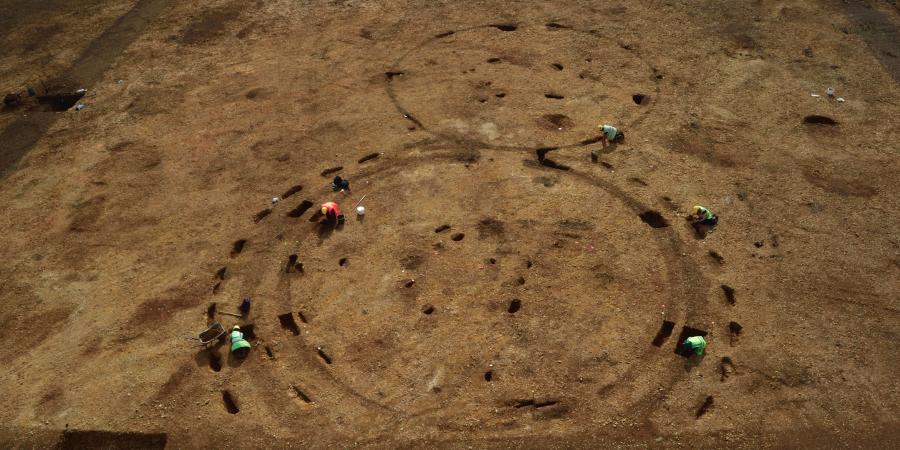An archaeological excavation at Exeter Down, on the western outskirts of Stamford (Lincolnshire), has uncovered an Iron Age farmstead with important evidence for early iron production. Initial programmes of geophysical survey, cropmark analysis and trench evaluation identified two areas of particular archaeological potential within the development site.
Area 1 contained a sequence of three roundhouses. The first two may have been built in open country, whereas the third lay within a 0.3-hectare rectangular enclosure defined by a substantial ditch and probable internal bank. In a clear indication of the development of the settlement, the second roundhouse had been cut through by both the enclosure ditch and the third roundhouse. Pottery and radiocarbon dates indicate the settlement spanned the transition from the Early to Middle Iron Age.


View of Area 1 and roundhouses under excavation (facing south east).
Photographs courtesy Aerial-Cam.
Within Area 2, two furnaces, field boundary ditches and a cluster of pits were exposed. Both furnaces contained the type of slag produced during the smelting of iron ore to produce useable metal; pink scorching visible on the earth surrounding the furnaces illustrates the high temperatures involved. Although no dating material was obtained from the furnaces, the presence of ore and smelting debris in other, better-dated, features in Areas 1 and 2 suggests that iron was being made on the site sometime during the period between the 5th and 2nd centuries BC.
The site lies on a large belt of iron-rich geological deposits where there is plentiful evidence for iron working during the Late Iron Age and Roman-British period. The remains found at Exeter Down, however, appear to be notably early examples. Furthermore, analysis of the slag from the furnaces suggests that, despite their relatively early date, they were operated in a very efficient way, with a large proportion of useable iron extracted from the ore.
Excavation of the an Iron Age ditch in Area 1 and an iron smelting furnace.
Despite the evidence for skilled iron smelting, the site’s inhabitants were farmers first and foremost, engaged in mixed farming with an emphasis on livestock (cattle and sheep/goat, with some pig). Cereals grown include the barley and spelt wheat typical of the region and period.
Overall the archaeological investigations at Exeter Down have made an important contribution to improving the understanding of how this part of Lincolnshire was settled and farmed during the Early to Middle Iron Age, and the part it played in the spread of iron working skills.
The archive has been deposited with The Collection, Lincoln under the accession code LCNCC: 2014-91. A summary of the results will be published in Lincolnshire History and Archaeology, and an article on the site’s iron smelting remains will be published in Historical Metallurgy .
The fieldwork was commissioned by CgMs Consulting, working on behalf of Taylor Wimpey (East Midlands) in advance of a housing and business park development. The archaeological study has also been supported by The Trustees for Burleigh House.
Read or download the full report below.

